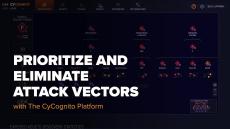- January 2025 (3)
- December 2024 (3)
- November 2024 (5)
- October 2024 (9)
- September 2024 (7)
- August 2024 (1)
- July 2024 (4)
- June 2024 (3)
- May 2024 (8)
- April 2024 (3)
- March 2024 (3)
- February 2024 (2)
- December 2023 (1)
- October 2023 (3)
- September 2023 (5)
CyCognito solves one of the most fundamental business problems in cybersecurity: seeing how attackers view your organization, where they are most likely to break in, what systems and assets are at risk and how you can eliminate the exposure.
Founded by national intelligence agency veterans, CyCognito has a deep understanding of how attackers exploit blind spots and a path of least resistance. Based in Palo Alto, CyCognito serves a number of large enterprises and Fortune 500 organizations, including Colgate-Palmolive, Tesco and many others.
Automated external attack surface management and continuous testing reduces your overall risk:
- Discovery: Proactively uncover exposed external assets — without input or configuration — using attacker reconnaissance approaches.
- Contextualization: Empower your team to know what an asset does, where it’s located, what other assets it connects to, and how attractive it is from that attacker perspective.
- Active Security Testing: Launch security testing across your full inventory of external assets, enabling a new level of visibility into risk and the steps needed to reduce it.
- Prioritization: Automate risk prioritization for external assets to focus your security team’s attention and energy on the 10 to 50 most critical exploited assets that matter the most.
- Remediation Acceleration: Quickly repair exploitable assets and reduce validation time from months to hours to swiftly prevent data breaches.
Discover, test and prioritize all of your web assets and applications.

























